|
|
|
Sort Order |
|
|
|
Items / Page
|
|
|
|
|
|
|
| Srl | Item |
| 1 |
ID:
114277
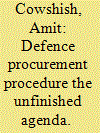

|
|
|
|
|
| Publication |
2012.
|
| Summary/Abstract |
It has been a long time since the first set of instructions on defence procurement was issued in 1992. Since then, however, there have been several refinements and additions, based on the feedback from the stakeholders and the experience of the Defence Ministry itself, culminating in the Defence Procurement Procedure (DPP) 2011. This is presently under review and it would be reasonable to expect that the changes being contemplated will result in further refinement of the procedure and address some of the concerns expressed from time to time. There is also a view that all this effort may go waste once the Public Procurement Bill, presently before Parliament, is enacted, as the law would also apply to defence-related procurements. The apprehension seems unwarranted. The fundamental principles underlying the DPP are not materially different from what is envisaged in the proposed law on public procurement, but the DPP contains detailed instructions and formats of various documents peculiar to defence procurements. Therefore, it is quite likely that the DPP would survive, in some form or the other, the enactment of law on public procurement. Some further changes might be necessary to bring it in sync with the provisions of the new law, but these changes are unlikely to bring about any material change in the overall procedure for capital procurements which has developed over the years. The process of refining the procedure must, therefore, continue. It is in this context that this article highlights some of the issues that have so far not received enough attention or have not been perceived as problem areas meriting attention.
|
|
|
|
|
|
|
|
|
|
|
|
|
|
|
|
| 2 |
ID:
114282
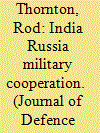

|
|
|
|
|
| Publication |
2012.
|
| Summary/Abstract |
This article considers the relationship-in defence terms-between India and Russia. It looks at the level of military cooperation and the nexus the two countries have created in regard to arms transfers and their joint research into, and production of, weapons systems. This relationship is, of course, one that is constantly evolving as different strategic and political pressures come to bear. The analysis here concentrates on the current standing of the defence links between Delhi and Moscow. Evidence is presented to show that, at the moment, Russia is keen for both political and economic reasons to see the relationship continue to grow. India, for its part, is not quite so enthusiastic. But this is, as this article argues, a relationship that does seem to offer significant advantages to both sides. It has come under strain, yes, but it makes perfect sense for it not only to continue, but also to actually strengthen.
|
|
|
|
|
|
|
|
|
|
|
|
|
|
|
|
| 3 |
ID:
114279
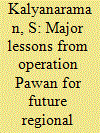

|
|
|
|
|
| Publication |
2012.
|
| Summary/Abstract |
The Indian intervention in Sri Lanka throws up five major lessons for future regional stability operations. Firstly, it is imperative to define the mission unambiguously and establish a clear mandate. Secondly, there is need for a robust military contingency planning process as well as discussions at various levels within the system to refine plans and provide an adequate force to meet possible eventualities. Thirdly, clear command and control needs to be established at the outset and the appropriate field formation must be designated as the headquarters. Fourthly, intelligence planning and coordination need to be made comprehensive, and adequate expertise and capabilities must be built up in advance. Finally, the importance of engaging in civil affairs tasks must be factored into the planning process, for which purpose the requisite data must be collated and plans formulated.
|
|
|
|
|
|
|
|
|
|
|
|
|
|
|
|
| 4 |
ID:
114281
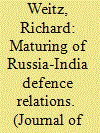

|
|
|
|
|
| Publication |
2012.
|
| Summary/Abstract |
Defence cooperation between Russia and India remains strong because of shared security concerns, geopolitical imperatives, and economic benefits. Both countries fear radical Islamic terrorism, share concerns about regional instability in Central Asia, and are uneasy with US military hegemony and the rise of China. Powerful interest groups in both countries also have a common interest in sustaining Russian arms sales to India. Russia's defence industry needs foreign sales to achieve economies of scale and sustain a manufacturing base that remains excessive for simply meeting Russian domestic demand. India has an enormous legacy of Soviet-based weapons that it needs to modernize, upgrade, and replace. In addition, Russian arms supplies continue to offer a good price-performance trade-off. But recurring problems with some Indian purchases along with along with India's changing geopolitical orientation could eventually displace Russia's currently pre-eminent status in India's foreign military purchases.
|
|
|
|
|
|
|
|
|
|
|
|
|
|
|
|
| 5 |
ID:
114284
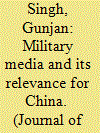

|
|
|
|
|
| Publication |
2012.
|
| Summary/Abstract |
The role of the media in China has been one where it is expected to be the 'mouthpiece' of the party. Media outlets have been used by the Chinese Communist Party (CCP) as propaganda wings and are expected to inform the people about the CCP's policies and actions. In addition, the introduction of the Internet has transformed the media landscape. There has been a steady increase in the number of Internet users and blogs in China. In 2011, the number of Internet users was around 513 million.1 Broadly, the Chinese media can be divided into three categories: the party media, the military media, and the business media. This commentary attempts to analyse the role of the military media in China.
|
|
|
|
|
|
|
|
|
|
|
|
|
|
|
|
| 6 |
ID:
114276
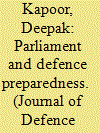

|
|
|
|
|
| Publication |
2012.
|
| Summary/Abstract |
The leakage of the former Army Chief General V.K. Singh's secret letter of 12 March 2012 to the Prime Minister, on large scale deficiencies in the Army, created an uproar in Parliament. While the issue of who leaked the letter and the motive behind the leak is under investigation by intelligence agencies, the bigger aspect that needs to be examined is how did we reach this level of hollowness, and what needs to be done to rectify the situation and avoid a recurrence in the future. In this context, among others, the Parliament of the country has a definite responsibility to discharge its duties in ensuring the readiness of the armed forces at all times.
|
|
|
|
|
|
|
|
|
|
|
|
|
|
|
|
| 7 |
ID:
114283


|
|
|
|
|
| Publication |
2012.
|
| Summary/Abstract |
This paper interrogates the concept of grand strategy. Its proponents argue that the absence of a publicly articulated and coherent grand strategy leads to incoherence in practice: armed forces acquire technologies without a strategy, government departments pursue their specific interests without reference to overarching national goals, and diplomats have a hard time explaining India's behaviour to foreign interlocutors. Despite its apparent desirability, the concept of grand strategy has come to mean different things to different thinkers depending on their vision of the world, their conceptions about the nature of power, their institutional affiliations, and the interests they seek to pursue. A proper understanding of grand strategy, therefore, is a first step towards its development. This paper presents multi-dimensional aspects of the concept and identifies its implications for practice.
|
|
|
|
|
|
|
|
|
|
|
|
|
|
|
|
| 8 |
ID:
114280


|
|
|
|
|
| Publication |
2012.
|
| Summary/Abstract |
India's defence forces have to be continually prepared with modernised assets and a well-planned and executed supply-chain network. This calls for a well-evolved logistics infrastructure. To achieve this, a close study of the extant procurement procedure, the process of allocation of the budget, and the lacunae therein, is necessary. This article ponders on the challenges or peculiarities faced during the revenue procurement process for the Indian Army. Defence procurement, unlike procurement or other departments, involves a deliberate and complex procedure. It has to include constant reforms and flexibility integrating not just feedback from end-users and the approving authorities, but also the everchanging defence perception. An integrated and synergized approach under a firm monitoring force performing within a strict time frame in a transparent manner, will definitely help in delivering the right goods affirming our operational preparedness and efficiency.
|
|
|
|
|
|
|
|
|
|
|
|
|
|
|
|
| 9 |
ID:
114278


|
|
|
|
|
| Publication |
2012.
|
| Summary/Abstract |
If there is one dimension in the air attack-air defence continuum that is riding high on the wings of enabling edge technologies, it is the use of stealth, both in the offensive and defensive domains. While a multiplicity of modern day aerial threat vehicles like B-2, F-22, F-117A, SU 35, JXX/J-20, UH-60, Mig 35, etc., are relying on latest stealth techniques to increase their survivability (and, hence, kill capability) in active air defence environments dotted by a hierarchy of sensors in range and depth, the air defence warriors are busy fielding high technology and high-definition sensors in active, passive, and electromagnetic (EM) based anti-stealth domains to defy stealthy attack. The cause-effect duel, thus, continues eternally.
This paper presents certain emerging thoughts and continuing debates in the field of stealth and counter-stealth.
|
|
|
|
|
|
|
|
|
|
|
|
|
|
|
|
|
|
|
|
|